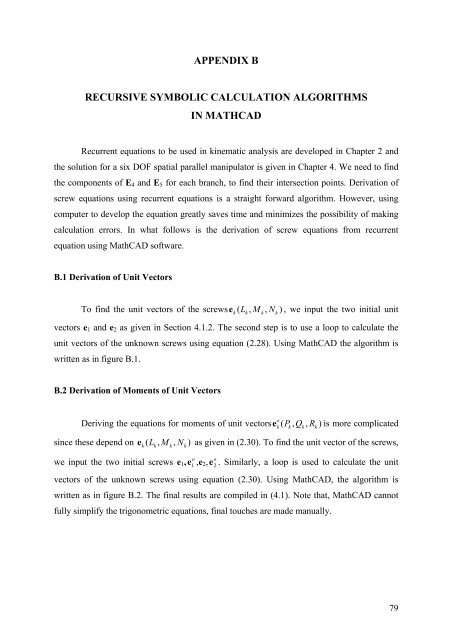Kinematic and Dynamic Analysis of Spatial Six Degree of Freedom ...
Kinematic and Dynamic Analysis of Spatial Six Degree of Freedom ...
Kinematic and Dynamic Analysis of Spatial Six Degree of Freedom ...
Create successful ePaper yourself
Turn your PDF publications into a flip-book with our unique Google optimized e-Paper software.
APPENDIX B<br />
RECURSIVE SYMBOLIC CALCULATION ALGORITHMS<br />
IN MATHCAD<br />
Recurrent equations to be used in kinematic analysis are developed in Chapter 2 <strong>and</strong><br />
the solution for a six DOF spatial parallel manipulator is given in Chapter 4. We need to find<br />
the components <strong>of</strong> E4 <strong>and</strong> E5 for each branch, to find their intersection points. Derivation <strong>of</strong><br />
screw equations using recurrent equations is a straight forward algorithm. However, using<br />
computer to develop the equation greatly saves time <strong>and</strong> minimizes the possibility <strong>of</strong> making<br />
calculation errors. In what follows is the derivation <strong>of</strong> screw equations from recurrent<br />
equation using MathCAD s<strong>of</strong>tware.<br />
B.1 Derivation <strong>of</strong> Unit Vectors<br />
To find the unit vectors <strong>of</strong> the screws e k ( Lk<br />
, M k , Nk<br />
) , we input the two initial unit<br />
vectors e1 <strong>and</strong> e2 as given in Section 4.1.2. The second step is to use a loop to calculate the<br />
unit vectors <strong>of</strong> the unknown screws using equation (2.28). Using MathCAD the algorithm is<br />
written as in figure B.1.<br />
B.2 Derivation <strong>of</strong> Moments <strong>of</strong> Unit Vectors<br />
o<br />
Deriving the equations for moments <strong>of</strong> unit vectors ek ( Pk<br />
, Qk<br />
, Rk<br />
) is more complicated<br />
since these depend on e k ( Lk<br />
, M k , Nk<br />
) as given in (2.30). To find the unit vector <strong>of</strong> the screws,<br />
we input the two initial screws e1, e ,e2, e . Similarly, a loop is used to calculate the unit<br />
o<br />
1<br />
o<br />
2<br />
vectors <strong>of</strong> the unknown screws using equation (2.30). Using MathCAD, the algorithm is<br />
written as in figure B.2. The final results are compiled in (4.1). Note that, MathCAD cannot<br />
fully simplify the trigonometric equations, final touches are made manually.<br />
79
















